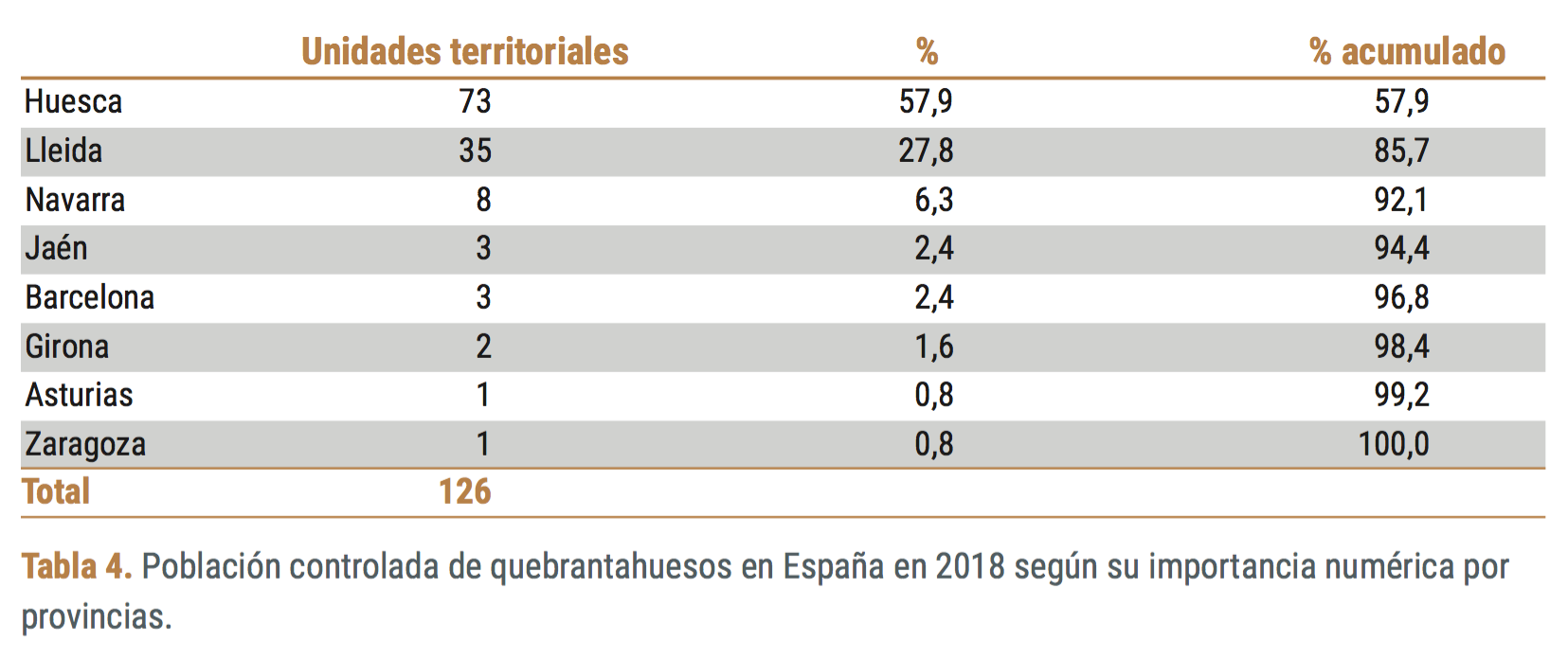
The monograph “The Bearded Vulture in Spain — Breeding population in 2018 and the census method” has been recently published by Instituto de Investigación en Recursos Cinegéticos (IREC – CSIC, UCLM, JCCM).
The work is the result of collecting data and information that synthesizes everything known about the population status, distribution and reproductive parameters of the Bearded Vulture until 2018. In this way, it collects data on the actions carried out through the Recovery Plans of the species in the autonomous communities of Navarra, Aragon and Catalonia, as well as the actions promoted by the Strategy for the Conservation of the Bearded Vulture in Spain, coordinated by Ministerio para la Transición Ecológica y el Reto Demográfico.
It also includes data obtained in the framework of reintroduction projects coordinated by the Andalusian Government and the Principality of Asturias. The editors’ objective is to update it every 10 years, as is the case with other national censuses of other species of vultures, in order to be able to compare the population trend of the Bearded Vulture with that of the rest of European vulture species.
Bearded Vulture conservation in Spain
The Bearded Vulture conservation actions in the Pyrenees carried out within the framework of the recovery plans developed by the various administrations (Aragon, Catalonia and Navarra) have resulted in the gradual recovery of the species. The following actions have favoured the increase in the Bearded Vulture population in the Pyrenees: monitoring of nests, hunting regulation, establishment and maintenance of supplementary feeding station, marking dangerous power lines, tackling illegal use of poisoned baits and studying the ecology of the species to apply targeted conservation actions.
In 2010, within the Comité de Flora y Fauna formed by representatives of Autonomous Communities and the Ministerio para la Transición Ecológica y el Reto Demográfico, the working group for the Bearded Vulture Working Group in Spain prepared the “Proposal of bases for the development of Programme for the ex-situ conservation of the Bearded Vulture in Spain” to coordinate and give mutual support to the ex-situ conservation projects that were being carried out or were in the initiation phase (the constitution of a Pyrenean genetic reserve in Catalonia; the programme for the reintroduction in Andalusia and the project for the reintroduction of the Bearded Vulture in the Picos de Europa National Park).
The first one carried out in the Iberian Peninsula was in Andalusia, where the first specimens were released in 2006 — a project led by the Junta de Andalucia in collaboration with the Vulture Conservation Foundation (VCF). The released vultures were captive-bred that came from the Bearded Vulture Captive Breeding Network, which is part of the European Endangered Species Programme (EEP), and is coordinated by the VCF. They were released using the hacking method, where birds are released in a remote artificial nest to acclimatize to the environment until they fledge. This method is more or less the ‘natural’ way of fledging.

Later, another reintroduction project started in Asturias in 2010 based on the extraction of clutches from the Pyrenees for their subsequent breeding in captivity and release by hacking. Although the first experimental releases began in 2010 (FCQ, 2019), a LIFE project (LIFE 12 NAT/ ES/000322) has been the driving force behind the project between September 2013 to September 2018.
More recently in 2018, another reintroduction project started in the Valencian Community, which combines the release of specimens (chicks) from the Bearded Vulture EEP using the hacking method, with the experimental release of non-breeding adult individuals from the Pyrenees. The project is led by the Generalitat of Valencia, in collaboration with the Autonomous Communities from Aragón and Catalonia, the Spanish Ministry of Agriculture, Fish, Food and Environment and the us here at the Vulture Conservation Foundation.

Of the three ex-situ projects carried out in Spain, Andalusia has already had the first successful breeding (in 2015, 2017 and 2018) and Asturias has already seen the first clutches (2017 and 2018; FCQ, 2019). The information collected in this monograph forms part of the actions carried out through the Recovery Plans for the species in the autonomous communities of Navarre, Aragon and Catalonia, as well as the actions promoted by the Strategy for the Conservation of the Bearded Vulture in Spain, coordinated by the current Ministry for Ecological Transition and the Demographic Challenge. Likewise, the data referring to Andalusia and Asturias have been obtained within the framework of two reintroduction projects coordinated by the Andalusian Government and the Principality of Asturias, respectively. The objective of this document is to synthesize the available information on the population status, distribution and reproductive parameters of the species until 2018.
Results
In 2018, 126 occupied territorial units were controlled in Spain, of these, 35 (27.8%) were polyandrous formations, and 86 have started reproduction. The Bearded Vulture is present as a breeder in five autonomous communities: 3 in Andalusia, 74 in Aragon, 1 in Asturias, 40 in Cata-Lauña and 8 in Navarre. There are regular observations in the area of the Basque Country bordering Navarre with a first nest building attempt in the 2017-2018 season.
Download and review the Monograph below.
Bearded Vulture in Spain Monograph
Monografico-quebrantahuesos-Espana-IREC-
Adobe Acrobat Document 3.6 MB









